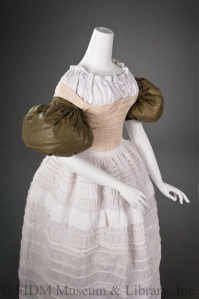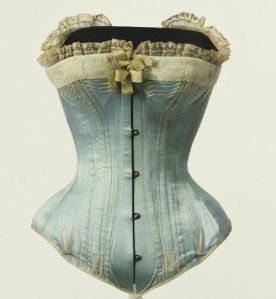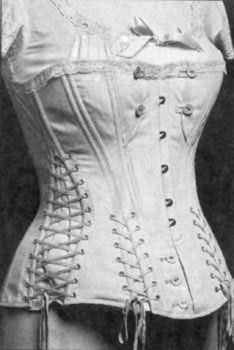 As I’m sure you’ve figured out by now, I primarily write historical fiction. This means researching not only social mores, foods, and events, but also fashion. When you are looking at the various women’s silhouettes that were en vogue throughout history, you have to also look at the underpinnings that created them.
As I’m sure you’ve figured out by now, I primarily write historical fiction. This means researching not only social mores, foods, and events, but also fashion. When you are looking at the various women’s silhouettes that were en vogue throughout history, you have to also look at the underpinnings that created them.

I’m not going to lie; women essentially wore two full sets of clothing throughout most of history. The underthings were almost as heavy as the outer garments. Corsetry and petticoats were made to fit a given woman’s shape into the styles of the day. Let’s go back to the earliest period in which I’ve written: the Regency, which is when Clytie’s Caller is set. Clytie’s stays (like the ones at the right) would have kept her figure pretty straight, in line with the Empire-waisted dresses that were in fashion at the time.

Moving forward in time, we come to the Romantic era, as written about in Bayou Fire. Some of you may recall my early post about idiot sleeves. Well, the underpinnings at the left are part of how those sleeves kept their shape. The “plumpers” on the chemise, and the heavily corded petticoats, gave shape to the dresses of the time.

Then we come to the late Victorian era, in which the majority of the Seen Through the Phantom’s Eyes series is set. The silhouette has changed yet again, becoming more wasp-waisted and constrained. In In The Eye of The Beholder, I describe Claire’s best corset as being covered in blue china silk. This image is pretty much how I imagined it looking.
It is worth noting that bloomers were not really worn until the late Regency/early Romantic era; it was all about the stays and petticoats throughout most of history.

I have also been a historical reenactor so yes, I have worn stays and petticoats. I own three corsets, one of them custom-made, all from Dark Garden. If you are interested in corsetry or period attire like this, my plea is that you have a fitting and get a piece that is right for your body. When I first started reenacting, I borrowed a Victorian corset from a woman much more long-waisted than I am, and the resulting bruises on my hips and overall discomfort were off-putting. If your corset fits right, it is just as comfortable as any modern-day underpinnings — once you’ve gotten used to wearing it. Remember, in the periods I write about, young women would have been corseted since puberty, so they were accustomed to it. They even corseted during pregnancy; stays were the primary foundation garment in daily life. We are no longer in the habit of corseting, since the modern bra (the original patent for a brassiere was in 1889) came into widespread use during World War I so that corset metal could go to the war effort. Thus, some care and training is required, wearing your corset only for an hour or two each day at first and gradually increasing the time you do so.
Cool information — so glad I don’t have to wear any of ’em!
LikeLike
The first time I wore one, suffice to say that I was suddenly very self-aware! I had to think about how I sat down, how I walked … and a whole lot more. I have friends who wear them daily … but I just can’t.
LikeLike
OMG! To be corseted during pregnancy! Yikers! This is an interesting post that I am forwarding to a friend (not in the Challenge) who will find it fascinating. One of my personas (Caroline Adams) as yet unpublished writes historical fiction. I’ll pass this along to her, too. LOL
Angelica French at “Romance Righter”
LikeLike
Remember, corseting was just as normal to women during these periods as wearing bras is for us today. So, it would have been considered completely normal. There were specialized corsets for horseback riding, too. Thanks for stopping by, and for sharing with your other readers!
LikeLike
Think how much better our posture would be if corsets were still the norm. Bras don’t do much in the way of keeping you from sloppily slouching.
http://laurelgarver.blogspot.com/2017/04/u-unexpected.html
LikeLike
They really do make you aware of how you stand and sit; slouching in a corset can be done with a great deal of effort, but the pinching is painful.
LikeLike
Thanks for this fascinating history of women’s undergarments. “If your corset fits right, it is just as comfortable as any modern-day underpinnings— once you’ve gotten used to wearing it.” I can’t imagine ever getting used to wearing something like that! 🙂 As you said though, it was normal back then and girls started young. They didn’t know anything different.
LikeLike
Honestly, I likened it to getting accustomed to one’s first brassiere. Eventually you don’t notice, but at first you can’t help be aware of it all the damn time!
LikeLiked by 1 person
This was very interesting, Sharon! I remember wearing a girdle up to the early 60’s …… and then FREEDOM! I was so young then and didn’t even need one in the late 50’s – early 60’s. Now?? … is another story. 😀 ( I didn’t know about the metal for the war effort in World War II.)
http://www.meinthemiddlewrites.com
LikeLike
I hope I typed WW I — because that’s what I meant. I may need to go back and fix it!
I remember my grandmother’s girdles hanging up in the bathroom; she called them her garter belts, because of course that was how you affixed your stockings back in the day. I’m not sorry to have grown up late enough that girdles were no longer considered a mandatory part of one’s attire!
LikeLiked by 1 person
Just checked! You did ……..where was my thinking!!? There were all sorts of health problems linked to wearing girdles ….. not to mention they served as a sort of ‘chastity belt’ in the 50’s. Then the 60’s came along!
LikeLiked by 1 person
Reblogged this on Sharon E. Cathcart and commented:
I’m reblogging this 2017 post on historical underpinnings; Claire’s corset from In The Eye of The Beholder is referenced. Enjoy!
LikeLike